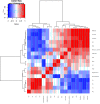A nose for trouble: ecotoxicological implications for climate change and disease in Saiga antelope (S. t. tatarica)
- PMID: 38367154
- PMCID: PMC10874336
- DOI: 10.1007/s10653-024-01874-y
A nose for trouble: ecotoxicological implications for climate change and disease in Saiga antelope (S. t. tatarica)
Abstract
In recent decades, Saiga antelope (Saiga t. tatarica) mass die-offs have become more common. The mass die-off of 2015 in central Kazakhstan, recorded 140,000 individual deaths across multiple herds. Previously, research has shown atmospheric humidity, the bacterium Pasteurella multocida serotype B, and resultant haemorrhagic septicaemia, were the primary cause. However, other synergistic factors may have impacted this process. Here we use a multivariate compositional data analysis (CoDA) approach to assess what other factors may have been involved. We show a pollutant linkage mechanism where relative humidity and dewpoint temperature combine with environmental pollutants, potentially toxic elements (e.g., Hg, As), complex carbon compounds (e.g., Acetone, Toluene), and inorganic compounds (e.g., CHx, SO2) which affected the Saiga during the calving season (start and peak) and at the onset of the mass die-off. We suggest a mechanism for this process. Upon arrival at their carving grounds, the Saiga experienced a sudden precipitation event, a spike in temperatures, and resultant high humidity occurs. The infectious bacterium P. multocida serotype B then spreads. Further, environmental pollutants contained within steppe soils are released to the air, forming localised smog events, these synergistically combine, and mass die-off occurs.
Keywords: Compositional data analysis (CoDA); Environmental pollution; Epidemiological; Saiga mass die-off; Smog.
© 2024. The Author(s).
Conflict of interest statement
We have no competing interests to declare.
Figures





Similar articles
-
Mass Die-Off of Saiga Antelopes, Kazakhstan, 2015.Emerg Infect Dis. 2019 Jun;25(6):1169-1176. doi: 10.3201/eid2506.180990. Emerg Infect Dis. 2019. PMID: 31107235 Free PMC article.
-
Biological characterization of Pasteurella multocida present in the Saiga population.BMC Microbiol. 2019 Feb 11;19(1):37. doi: 10.1186/s12866-019-1407-9. BMC Microbiol. 2019. PMID: 30744550 Free PMC article.
-
Gut microbiota of the critically endangered Saiga antelope across two wild populations in a year without mass mortality.Sci Rep. 2023 Oct 11;13(1):17236. doi: 10.1038/s41598-023-44393-z. Sci Rep. 2023. PMID: 37821478 Free PMC article.
-
[The Mongolian saiga: its present status and preservation outlook].Izv Akad Nauk Ser Biol. 1997 Mar-Apr;(2):177-85. Izv Akad Nauk Ser Biol. 1997. PMID: 9190220 Review. Russian.
-
The Minderoo-Monaco Commission on Plastics and Human Health.Ann Glob Health. 2023 Mar 21;89(1):23. doi: 10.5334/aogh.4056. eCollection 2023. Ann Glob Health. 2023. PMID: 36969097 Free PMC article. Review.
References
-
- Almaganbetov N, Grigoruk V. Soil chemical pollution, risk assessment, remediation and security. Springer; 2008. Degradation of soil in Kazakhstan: Problems and Challenges; pp. 309–320.
-
- Aznar FJ, Perdiguero D, Del Olmo AP, Repullés A, Agustí C, Raga JA. Changes in epizoic crustacean infestations during cetacean die-offs: The mass mortality of Mediterranean striped dolphins Stenella coeruleoalba revisited. Diseases of Aquatic Organisms. 2005;67(3):239–247. doi: 10.3354/dao067239. - DOI - PubMed
-
- Campos PF, Kristensen T, Orlando L, Sher A, Kholodova MV, Götherström A, Hofthemer M, Drucker DG, Kosintsev P, Tikhonov A, Baryshnikov GF. Ancient DNA sequences point to a large loss of mitochondrial genetic diversity in the saiga antelope (Saiga tatarica) since the Pleistocene. Molecular Ecology. 2010;19(22):4863–4875. doi: 10.1111/j.1365-294X.2010.04826.x. - DOI - PubMed
-
- Clifford AB, Witmer LM. Case studies in novel narial anatomy: 3) Structure and function of the nasal cavity of saiga (Artiodactyla: Bovidae: Saiga tatarica) Journal of Zoology. 2004;264(3):217–230. doi: 10.1017/S0952836904005540. - DOI
MeSH terms
Substances
LinkOut - more resources
Full Text Sources
Research Materials

